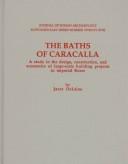| Listing 1 - 5 of 5 |
Sort by
|
Book
Year: 1951 Publisher: Berlin : W. de Gruyter,
Abstract | Keywords | Export | Availability | Bookmark
 Loading...
Loading...Choose an application
- Reference Manager
- EndNote
- RefWorks (Direct export to RefWorks)

ISSN: 10634304 ISBN: 1887829253 9781887829250 Year: 1997 Volume: no. 25 Publisher: Portsmouth : Journal of Roman Archaeology,
Abstract | Keywords | Export | Availability | Bookmark
 Loading...
Loading...Choose an application
- Reference Manager
- EndNote
- RefWorks (Direct export to RefWorks)
Architecture, Roman --- Public baths --- Architecture romaine --- Bains publics --- Baths of Caracalla (Rome, Italy) --- Rome --- Antiquities. --- Antiquités --- Antiquités --- Baths, Public --- Baths --- Public buildings --- Hammams
Book
ISBN: 9783700140023 3700140029 Year: 2008 Volume: 15 Publisher: Wien Verl. der Österreichischen Akademie der Wissenschaften
Abstract | Keywords | Export | Availability | Bookmark
 Loading...
Loading...Choose an application
- Reference Manager
- EndNote
- RefWorks (Direct export to RefWorks)
Book
ISBN: 9780190614782 Year: 2018 Publisher: [New York, NY] : Oxford University Press,
Abstract | Keywords | Export | Availability | Bookmark
 Loading...
Loading...Choose an application
- Reference Manager
- EndNote
- RefWorks (Direct export to RefWorks)
Across the Roman Empire, ubiquitous archaeological, art historical, and literary evidence attests to the significance of bathing for Romans' routines and relationships. Public baths were popularly viewed as necessities of daily life and important social venues. Given the importance of bathing to the Roman style of living, by endowing eight magnificent baths (the so-called imperial thermae) in the city of Rome between 25 BCE - 315 CE, imperial patrons greatly enhanced their popular and political stature.Decoration and Display in Rome's Imperial Thermae presents a detailed analysis of the extensive decoration of the best preserved of these bathing complexes, the Baths of Caracalla (inaugurated 216 CE). Maryl B. Gensheimer takes an interdisciplinary approach to existing archaeological data, textual and visual sources, and anthropological theories in order to generate a new understanding of the visual experience of the Baths of Caracalla and show how the decoration played a critical role in advancing imperial agendas.This reassessment of one of the most ambitious and sophisticated examples of large-scale architectural patronage in Classical antiquity examines the specific mechanisms through which an imperial patron could use architectural decoration to emphasize his own unique sociopolitical position relative to the thousands of people who enjoyed his benefaction. The case studies addressed herein — ranging from architectural to freestanding sculpture and mosaic — demonstrate that sponsoring monumental baths was hardly an act of altruism. Rather, even while they provided recreation for elite and sub-altern Romans alike, such buildings were concerned primarily with dynastic legitimacy and imperial largess. Decorative programs articulated these themes by consistently drawing analogies between the subjects of the decoration and the emperor who had paid for it. The unified decorative program — and the messages of imperial power therein — adroitly honored the emperor and consolidated his reputation
Decoration and ornament, Architectural --- Decoration and ornament, Roman --- Art and society --- Themes, motives. --- Caracalla, --- Art patronage. --- Baths of Caracalla (Rome, Italy)
Book
ISBN: 9780691193793 9780691226521 Year: 2022 Publisher: Princeton, N.J. Princeton University Press
Abstract | Keywords | Export | Availability | Bookmark
 Loading...
Loading...Choose an application
- Reference Manager
- EndNote
- RefWorks (Direct export to RefWorks)
"An illuminating reassessment of the architect whose innovative drawings of ruins shaped the enduring image of ancient Rome"
Architecture, Roman --- Architecture, Roman, in art. --- Classical antiquities in art. --- Ruins in art. --- Appreciation. --- Sangallo, Giuliano da, --- Criticism and interpretation. --- Architecture --- Drawing --- architectural drawings [visual works] --- Sangallo, da, Giuliano --- Rome --- Roman architecture --- San Gallo, Giuliano da, --- Da Sangallo, Giuliano, --- Ambrogio Lorenzetti. --- Ancient Roman architecture. --- Ancient Rome. --- Ancient monument. --- Andrea Mantegna. --- Andrea Palladio. --- Antonio Labacco. --- Antonio Manetti. --- Antonio da Sangallo the Younger. --- Arch of Constantine. --- Architectural drawing. --- Baldassare Castiglione. --- Baldassare Peruzzi. --- Basilica Aemilia. --- Basilica of Santa Maria Novella. --- Baths of Caracalla. --- Baths of Diocletian. --- Benvenuto Cellini. --- Bernardo Rossellino. --- Calumny of Apelles (Botticelli). --- Casa Buonarroti. --- Cassiano dal Pozzo. --- Cornice. --- Corsini. --- Cosmatesque. --- Daniele Barbaro. --- Dante Alighieri. --- De Re Aedificatoria. --- Domenico Ghirlandaio. --- Domus Aurea. --- Donatello. --- Doric order. --- Entablature. --- Filippino Lippi. --- Filippo Brunelleschi. --- Flavio Biondo. --- Florence Cathedral. --- Francesco Colonna. --- Francesco di Giorgio Martini. --- Giacomo Barozzi da Vignola. --- Giorgio Vasari. --- Giotto. --- Giuliano da Maiano. --- Giuliano da Sangallo. --- Giulio Romano. --- I quattro libri dell'architettura. --- Illustration. --- Italian Renaissance. --- Judea (Roman province). --- Lateran Baptistery. --- Luca Pacioli. --- Masaccio. --- Mausoleum of Galla Placidia. --- Mirabilia Urbis Romae. --- Oliviero Carafa. --- Ostia (Rome). --- Palace of Domitian. --- Palazzo Caprini. --- Palazzo Della Rovere. --- Palazzo Gondi. --- Palazzo Medici Riccardi. --- Palazzo della Cancelleria. --- Parchment. --- Peruzzi. --- Petrarch. --- Piero di Cosimo. --- Pietra serena. --- Pirro Ligorio. --- Poggio Bracciolini. --- Poliziano. --- Pope Julius II. --- Presentation at the Temple (Ambrogio Lorenzetti). --- Proportion (architecture). --- Prospero Colonna. --- Raffaele Riario. --- Renaissance architecture. --- Roman Empire. --- Roman Forum. --- Roman Renaissance. --- Roman army. --- Rome. --- San Giovanni dei Fiorentini. --- San Pietro in Montorio. --- Sandro Botticelli. --- Santa Costanza. --- Santa Maria in Trastevere. --- Sassetti Chapel. --- Sebastiano Serlio. --- Spolia. --- Temple of Bacchus. --- The Story of Lucretia (Botticelli). --- Theatre of Marcellus. --- Trajan's Column. --- Uffizi. --- Vatican City. --- Vatican Library. --- Vatican Museums. --- Villa Giulia. --- Vitruvian Man. --- Vitruvius. --- Drawing, Renaissance --- Drawing, Italian --- architectuur, Italië
| Listing 1 - 5 of 5 |
Sort by
|

 Search
Search Feedback
Feedback About UniCat
About UniCat  Help
Help News
News